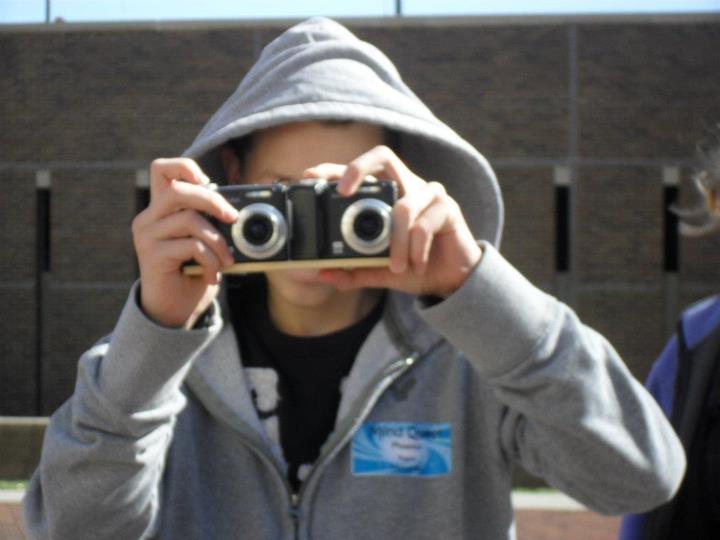STEM education relevant, fascinating and fun
By Cathy Beuten | CU system

CSTEME's mission is simple: Demonstrate that STEM education is accessible, fascinating, fun and, importantly, is relevant to their lives.
Through CSTEME, students create a solar oven out of a pizza box to make s'mores. They construct a solar-powered car, explore wind power and unravel a DNA fingerprinting mystery. They build Lego robots, construct circuits using Arduinos (small open-source microcontrollers) and test the waters of ponds on a virtual chinchilla farm where the critters are getting sick.
"STEM education used to require a high level of extensive skills," said David Khaliqi, director of the Center for STEM Education at UCCS. "A lot of tools are now more accessible. Kids can come in with no knowledge – they don't even know what an LED is – and it's amazing to watch this process where these tools give them the possibility of transformation."
The center's approach to STEM education is the antithesis of the old-fashioned cookbook curriculum, Khaliqi said.
"We have freedom to teach in an informal model," he said. "Students are expected to fail at some level; it makes them think about what to change. We get the students engaged, 'Try, test, didn't work, try, test, oh now it works,' in three- or four-minute cycles."
It used to be in lab class that if it didn't work, say, you got the wrong color, you added the right color and turned the project in, he said. Not at CSTEME. "We want them to explore, 'Why didn't we get that color? Why did that happen?' We bank on allowing students to make mistakes then fix it."
It's no mistake that one area in which in which CSTEME is succeeding is overcoming gender bias in the STEM fields, which have traditionally been male dominated. Khaliqi and his staff have recognized a key element to getting and keeping the girls engaged.
The plan is working. Some 55 percent of the students involved with CSTEME courses in 2012-13 were female. "The girls are as, or more, engaged as the boys," he said.
Khaliqi and his staff of five have also found that girls and underrepresented populations become engaged when they can see the social and societal benefits and problem-solving opportunities through STEM fields. Through its partnerships, CSTEME has had success reaching low-income, rural students – some through a popular 10-day residential camp partnering with ExxonMobil that brings together students from across the state.
In 2012-13, of the populations served by CSTEME:
- 28 percent were Hispanic
- 46 percent were first generation
- 37 percent were low income
- 37 percent were an ethnic minority
The center was initially funded in 2007 through the Air Force Office of Scientific Research through its Partnership in Innovative Preparation for Educators and Students (PIPES) grant, with the first student program launching in 2008. Khaliqi says early indications are showing impressive results.

Enrollment for STEM courses through the program has grown from 53 students in 2008 to 1,480 in 2012-13, he said. When you include all the workshops, weekend camps and other outreach, more than 6,000 students have benefited from the program, he said. Numbers from the second wave are being analyzed. And the stats for the waves soon after should be a strong indication of the program's impact, he said.
"In those two to three waves we have students forced to come to one program or another, they didn't actually choose to come to STEM program," Khaliqi said. "That will be a really robust group to look at next year in the fall."
CSTEME recognizes that STEM education must reach beyond the center, its workshops and programs across southern Colorado. It has to be part of a day-to-day curriculum. The second tier of the PIPES program emphasizes science and math teacher professional development; CSTEME is working with schools across the regions, in districts 11, 20 and 49.
"With some teachers, you get early adopters," Khaliqi said. "They take it and run with it. But the majority are very intimidated." Part of the solution is recognizing there are times when the classes can benefit from letting go of control. One example: Rather than prohibiting smartphones in the classroom, allow students to utilize them to access search engines for research purposes.
CSTEME's base funding – half its budget – comes from UCCS, including student support. The rest comes from foundations such as the Anschutz Foundation, the Women's Foundation and the Harris Foundation, which invests in community-based initiatives to support education, health and wealth. The center also has garnered corporate support and has received several grants through the Colorado Governor's Office, including the Arduinos microcontroller project.
The staff is small, Khaliqi said, but the goals are big and attainable. "It's really fun. We have a dedicated and awesome staff that does amazing things. We love what we do . . . to the point where there's a danger of doing too much of it."
But there's too much more to do to slow down, Khaliqi said. Now that programs such as CSTEME have been in place for a while, students are entering college with the expectation that the institution will be leading them onto the next steps.
"With freshmen coming in, we're finding they expect that to continue. Some faculty are entrenched in the old ways of doing things, such as simply lecturing to students. There's a wave of students expecting more than that."




